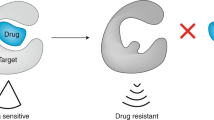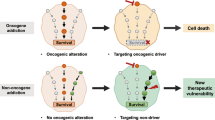Abstract
This issue is dedicated to Prof Hamao Umezawa in appreciation of his great contributions to pioneering research on antibiotics targeting oncogenes.
Similar content being viewed by others
Main
Professor Hamao Umezawa was a pioneer in cancer chemotherapy. In 1953, Professor Umezawa isolated the first antitumor compound, sarkomycin, from Streptomyces.1 The compound showed strong cytotoxic activity against several tumor cell lines but was not sufficiently effective in vivo for clinical use. Afterwards, Prof Umezawa continued to search for cytotoxic antitumor compounds of microbial origin and their synthetic derivatives, and by the mid 1980s, he had identified more than 20 novel compounds. Among these, bleomycin, aclacinomycin, peplomycin and pirarubicin have been the most outstanding successes and are used clinically for treating patients with several types of cancer.
At that time, Professor Umezawa pioneered a new approach for the development of anticancer drugs that target oncogenes. One great achievement of these efforts was the re-discovery of herbimycin A2 (Figure 1). By the early 1980s, oncogenes had been well characterized at the molecular level, and the results from studies in the field had provided new insights into the understanding of neoplastic transformation.3 In Rous sarcoma virus (RSV)-transformed cells, the functional expression of p60src (the src gene product) was shown to be required for manifestation of the oncogenic event.4 On the basis of these findings, in 1984 Professors Uehara, Hori, Takeuchi and Umezawa screened for compounds that were active in converting the transformed morphology of RSV-infected rat kidney cells to a normal morphology, which resulted in the identification an active compound produced by Streptomyces sp. MH237-CF8, herbimycin A.5, 6 In addition to p60src, herbimycin A was observed to inactivate oncogene functions of the p60src family. In particular, it showed differentiation-inducing activity against chronic myelogenous leukemia cell line K562,7 in which ABL is activated by chromosomal translocation (Philadelphia translocation). Furthermore, herbimycin A showed in vivo antitumor activity against FDC-P2 cells expressing BCR/ABL.8 It was then revealed that herbimycin A binds to heat shock protein HSP90 and destabilizes and decomposes members of the p60src family.9
Additional pioneering research of Professor Umezawa, in which the author took part in from the beginning, was the discovery of erbstatin. In 1979, the oncogene product p60src was discovered to catalyze tyrosine phosphorylation as a new type of protein modification.10 Following this discovery, ligand binding was observed to induce a rapid increase in epidermal growth factor (EGF) and platelet derived growth factor receptor tyrosine kinase (RTK) autophosphorylation.11, 12, 13 These findings suggested an important role of tyrosine phosphorylation in growth factor-mediated proliferation signals and in the src family oncogene-mediated signaling pathway for oncogenesis.
The discovery of the growth factor receptor and oncogene products associated with tyrosine kinase prompted us to screen for a compound that suppresses tyrosine kinase from the secondary metabolites of microorganisms. We did so using the membrane fractions of EGF receptors overexpressing the human epidermoid carcinoma cell line A431 as a source of tyrosine kinase. As a result, in 1986, a novel natural product named erbstatin was isolated as an inhibitor of EGF receptor tyrosine kinase from the cultured broth of Streptomyces sp. MH435-hF3 by the author, Dr Sawa, Dr Takeuchi and Professor Umezawa14 (Figure 1).
Erbstatin has a structure resembling tyrosine and shows a pattern of competitive inhibition with the protein to be phosphorylated.15 It is a broad spectrum tyrosine kinase inhibitor that also inhibits other receptor tyrosine kinases, such as Her-2, and non-receptor type tyrosine kinases, including Fyn and Lck. Although erbstatin is unstable in the presence of serum, it shows antitumor effects on leukemia cell line L1210 and breast cancer cell line MCF-7-bearing cancer mice by administering it in combination with a stabilizer.16 Following this epochal discovery, numerous inhibitors of tyrosine kinase were synthesized worldwide beginning in the late 1980's. In particular, Professor Tatsuta et al. and Prof Umezawa synthesized several erbstatin analogs,17, 18 and Yaish et al. synthesized a group of tyrosine kinase inhibitors called tyrophostins (Figure 1) using erbstatin as a model.19 Although Professor Umezawa passed away in 1986, the screening of tyrosine kinase inhibitors was succeeded by his first son, Professor Kazuo Umezawa, who discovered a novel compound, lavendustin A (Figure 1), from Streptomyces griseolavendus in 1989.20
Today, many tyrosine kinase inhibitors, such as gefitinib and imatinib, are clinically used to treat patients with several types of cancer. Thus, the discovery of erbstatin by Professor Umezawa has greatly contributed to the subsequent study of the development of molecularly targeted therapeutic drugs for different cancers.
References
Umezawa, H., Takeuchi, T., Nitta, K., Yamamoto, T. & Yamaoka, S. Sarkomycin, an anti-tumor substance produced by Streptomyces. J. Antibiot. (Tokyo) 6, 101 (1953).
Ômura, S. et al. Herbimycin, a new antibiotic produced by a strain of Streptomyces. J. Antibiot. (Tokyo) 32, 255–261 (1979).
Bishop, J. M. Cellular oncogenes and retroviruses. Annu. Rev. Biochem. 52, 301–354 (1983).
Purchio, A. F., Erikson, E., Brugge, J. S. & Erikson, R. L. Identification of a polypeptide encoded by the avian sarcoma virus src gene. Proc. Natl Acad. Sci. USA 75, 1567–1571 (1978).
Uehara, Y., Hori, M., Takeuchi, T. & Umezawa, H. Screening of agents which convert transformed morphology of Rous sarcoma virus-infected rat kidney cells to 'normal morphology: identification of an active agent as herbimycin and its inhibition of intracellular src kinase. Jpn J. Cancer Res. (Gann) 76, 672–675 (1985).
Uehara, Y., Hori, M., Takeuchi, T. & Umezawa, H. Phenotypic change from transformed to normal induced by benzoquinonoid ansamycins accompanies inactivation of p60src in rat kidney cells infected with Rous sarcoma virus. Mol. Cell. Biol. 6, 2198–2206 (1986).
Honma, Y., Okabe-Kado, J., Hozumi, M., Uehara, Y. & Mizuno, S. Induction of erythroid differentiation of K562 human leukemic cells by herbimycin A, an inhibitor of tyrosine kinase activity. Cancer Res. 1989 49, 331–334 (1989).
Okabe, M. et al. In vivo antitumor activity of herbimycin A, a tyrosine kinase inhibitor, targeted against BCR/ABL oncoprotein in mice bearing BCR/ABL-transfected cells. Leuk. Res. 18, 867–873 (1994).
Whitesell, L. et al. Inhibition of heat shock protein HSP90-pp60v-src heteroprotein complex formation by benzoquinone ansamycins: essential role for stress proteins in oncogenic transformation. Proc. Natl Acad. Sci. USA 91, 8324–8328 (1994).
Collett, M. S., Purchio, A. F. & Erikson, R. L. Avian sarcoma virus-transforming protein, pp60src shows protein kinase activity specific for tyrosine. Nature 285, 167–169 (1980).
Ushiro, H. & Cohen, S. Identification of phosphotyrosine as a product of epidermal growth factor-activated protein kinase in A-431 cell membranes. J. Biol. Chem. 255, 8363–8365 (1980).
Pike, L. et al. Characterization of platelet-derived growth factor-stimulated phosphorylation in cell membrane. J. Biol. Chem. 258, 9383–9390 (1983).
Heldin, C.-H., Ek, B. & Rönnstrand, L. Characterization of the receptor for platelet-derived growth factor on human fibroblast. J. Biol. Chem. 258, 10054–10061 (1983).
Umezawa, H. et al. Studies on a new epidermal growth factor-receptor kinase inhibitor, erbstatin, produced by MH435-hF3. J. Antibiot. (Tokyo) 39, 170–173 (1986).
Imoto, M. et al. Kinetic studies of tyrosine kinase inhibition by erbstatin. J. Antibiot. (Tokyo) 40, 1471–1473 (1987).
Imoto, M. et al. Antitumor activity of erbstatin, a tyrosine protein kinase inhibitor. Jpn J. Cancer Res. 78, 329–332 (1987).
Isshiki, K. et al. Effective synthesis of erbstatin and its analogs. J. Antibiot. (Tokyo) 40, 1207–1208 (1987).
Isshiki, K. et al. Inhibition of tyrosine protein kinase by synthetic erbstatin analogs. J. Antibiot. (Tokyo) 40, 1209–1210 (1987).
Yaish, P. et al. Blocking of EGF-dependent cell proliferation by EGF receptor kinase inhibitors. Science 242, 933–935 (1988).
Onoda, T. et al. Isolation of a novel tyrosine kinase inhibitor, lavendustin A, from Streptomyces griseolavendus. J. Nat. Prod. 52, 1252–1257 (1989).
Author information
Authors and Affiliations
Corresponding author
Ethics declarations
Competing interests
The author declares no conflict of interest.
Rights and permissions
About this article
Cite this article
Imoto, M. Professor Hamao Umezawa opened up a new road for the development of molecularly targeted therapeutic drugs for cancers. J Antibiot 71, 37–38 (2018). https://doi.org/10.1038/ja.2017.139
Received:
Revised:
Accepted:
Published:
Issue Date:
DOI: https://doi.org/10.1038/ja.2017.139




